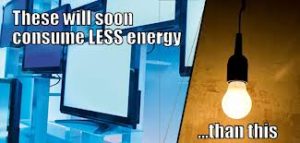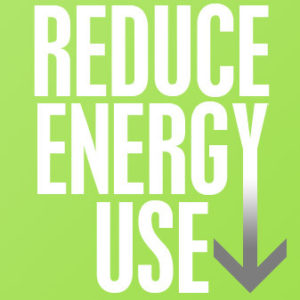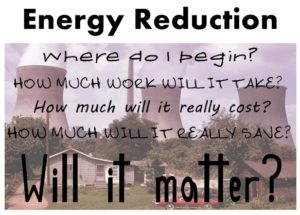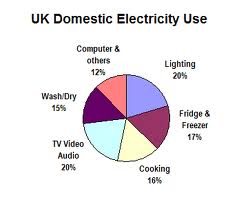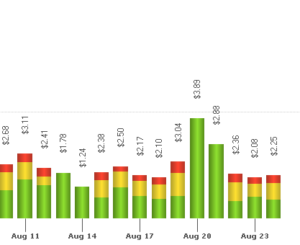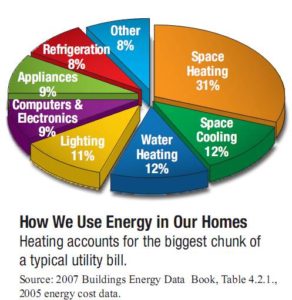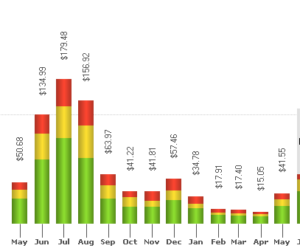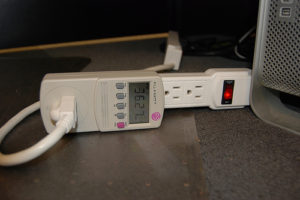 This post is about all of the energy efficient solutions that the average home owner might want to consider in an effort to reduce his or her total energy bill and make a contribution to reducing energy overall. This will save money too. We are covering a lot of different topics, which are listed below. Most people are more motivated about saving money than they are about saving energy. By focusing on Energy Efficient Solutions, they can reduce their utility bills and have extra money to spend in other areas. Scroll down to your area of interest or read the entire post.
This post is about all of the energy efficient solutions that the average home owner might want to consider in an effort to reduce his or her total energy bill and make a contribution to reducing energy overall. This will save money too. We are covering a lot of different topics, which are listed below. Most people are more motivated about saving money than they are about saving energy. By focusing on Energy Efficient Solutions, they can reduce their utility bills and have extra money to spend in other areas. Scroll down to your area of interest or read the entire post.
More Details
- Automobiles
- Driving Habits
- Jack Rabbit Starts & Stops
- High Speed
- Tune Ups
- Tire pressure
- Plan Trips
- Taking Public Transportation
- Walking vs. Driving
- Energy Use in the Home
- Switch to LED Lighting
- Electricity
- Heating Fuel
- Home Insulation
- Sealing Windows and Doors
- Setting the Thermostat
- Going on Vacation
- Turning the Lights Off
- Turning down the Water Heater Temperature
- Adding Insulation to the Hot Water Pipes
- Upgrade the Furnace to High Efficiency
- Outdoors
- Solar Blankets for the Pool
- Solar Heater for the Pool
- Power Lawn Mowers vs. Push Lawn Mowers
- Solar Lights
Energy Efficient Solutions – More Detail
Automobiles
Our cars and trucks are one of the largest energy consumers on the planet and our pocket book. Prices of gasoline and diesel fuel continue to go up, with gasoline recently reaching over $5 per gallon in California. We decided to include a large section just on cars that consumers can consider as a means of reducing their energy consumption in this area as part of the energy efficient solutions that we all should be striving for.
Driving Habits – play a large part in how much gasoline we actually use. Jack rabbit starts from stop signs and stop lights consume a huge amount of gasoline compared to gradual acceleration. Your car is designed for optimum energy efficiency at the speed limit. Any time you drive faster, the cost per mile or kilometer goes way up. Lots of one task trips, driving to work vs. walking or mass transit, lack of car pooling all contribute to poor overall energy efficiency. Maintenance of your car is another factor in the use of gasoline. Keeping your car at an optimum level of operation will also contribute to better gasoline mileage.
Jack Rabbit Starts & Stops
High speed acceleration literally burns gasoline at a huge rate, only to have to apply the brakes shortly after as you approach another stop sign, stop light or catch up to a car ahead of you. You wear down your brakes prematurely and there is more wear and tear on your tires. All of this hits your pocket book really hard. Brakes and tires are expensive to repair and the gasoline you use is becoming more expensive all of the time. Producing brakes and rubber tires uses a lot of energy as well so any time you delay the replacement of these components saves your pocket book at it increases your energy efficiency.
High Speed – Highway speed limits are designed for safety primarily. When it says 60 miles per hour or 100 kilometers per hour this is the speed that your car should be driven. It turns out that the optimum speed for maximum energy efficiency is near this speed as well. Anytime you drive faster than these speeds you are actually burning more gasoline or diesel fuel per mile than you would at lower speeds. In Texas and a number of other states, speed limits are set at 75 miles per hour and there is talk of increasing them even higher to 80 or 85 miles per hour. While the road can accommodate these speeds, your car’s engine is not designed for this speed in terms of fuel efficiency. Try an experiment sometime and measure the gas usage at various speeds and it will become self evident.
Tune Ups
Fresh oil, new spark plugs or injectors, the right kind of gasoline, a clean air filter all contribute to better gas mileage. Although it can be expensive to take the car to the garage and have a tune up completed, your car will be running at its maximum fuel efficiency.
Tire pressure
Low tire pressure is not only unsafe since your car is less maneuverable at high speeds when the tires are low on pressure, they also will cause your car to use more fuel. The reason is that they have more surface area touching the road and there is more resistance. This drives the use of fuel higher and your costs up. Check your tires pressure on a regular basis even if you have one of these tire pressure monitor systems installed. Your tires can be down a few pounds without the monitoring system alerting you to a low pressure condition. Check all of your tires on a regular basis.
Plan Trips – How many trips do you make every day? Could you combine some of them so you actually take the car out less? Anyone making multiple trips in the same direction is using far more gas than they need to, plus short trips were the engine does not fully warm up to operating temperature is actually harder on your car than a longer drive. Plan your trips so that all of your errands are done at the same time and even delay errands until you have several to make better use of your car and conserve gasoline.
Taking Public Transportation
There are still far too many people driving their cars vs. using mass transit systems. While there is a cost to using mass transit, compared to using your car, the cost of gasoline, the wear and tear on your car and parking costs, mass transit is a bargain at almost any cost. Stop driving, take mass transit and you will be far more relaxed when you get to work. Read, work or sleep while you on the transit system. It will bring your blood pressure down for sure.
Walking vs. Driving – Both of my kids have cars, yet they both walk to work. Imagine the money they are saving, how much they help the environment and the exercise they are getting. This is just a win, win situation. Anytime you can walk instead of taking your car saves gasoline and you get fresh air and exercise.
Energy Efficient Solutions – Energy Use in the Home
Now we are turning to the home, which is another large part of our lives and a huge energy user. If we can cut the cost of energy by 20% in our homes by using energy efficient solutions we are making a huge contribution to our pocket book and the environment. We will discuss a number of areas that most consumer home owners can consider and impact the cash they spend every day around their home from an energy perspective.
Switch to LED Lighting – If you are still using incandescent lights, it is time to switch to either fluorescent or LED lights. They save so much energy and last so much longer it just makes sense to switch. These kinds of light bulbs cost more, however the energy that is saved will ensure a relatively short payback even with the higher initial cost. In fact most stores are gradually switching over to the new lights and pretty soon you will not be able to purchase incandescent lights as well. Switch now for an immediate energy efficient solution.
Electricity
The cost of electricity is going up every year and it will continue to do so as we depend on oil and coal and lately natural gas to generate much of our electricity. Even nuclear fuel generating plants are costing more due to the increased safety concerns. Whenever you can reduce your electrical usage, you are saving money and also contributing to improving the environment. Turn lights off, take advantage of time of day electrical rates, use a microwave instead of a regular oven, turning down your thermostat in winter and up in the summer to reduce electrical usage will all reduce your electrical usage.
Some people can also use solar generators, windmills etc to generate their own electricity and reduce the load on the electrical grid. This takes more investment and know how, but there are situations where it makes sense and hopefully more energy efficient solutions will be available in the near term
Heating Fuel
Whether you heat and cool your home with electricity, natural gas or oil, the cost is going up all of the time. If you use less, then you are going to save money and use less energy. Turn down the thermostat in the winter time, especially when you are not at home. Turn up the thermostat in the summer time to reduce the cooling load. Consumers can save a significant amount of cost by following these steps. Use an electronic thermostat that you can program so that your home is automatically controlled while you are not at home. There are systems available now that allow you to control the temperature at home while you are away from home. Upgrade now if you do not have one of these.
Home Insulation
Brand new homes are very well insulated to today’s standards. Older homes, even homes that are only 5 years old will not be insulated to the same standard. Homes that are 20 years old and older will benefit from increase insulation and air exchange systems that will increase the energy efficiency of your home over all. Increase the insulation in your attic, change your windows to improve the insulating value and make sure that all caulking is up to date and that your home is well sealed. Combining improved insulation and some of the other suggestions we are making in this post will make a huge decrease in your overall energy use.
Sealing Windows and Doors – Windows and doors are prime areas were cold air can penetrate in the winter time and of course the reverse in the summer. Consumers can arrange for a pressure test to confirm were all of the air leaks are around your home and them take the steps necessary to install weather strips and caulking were needed. Another little known fact is that electrical plugs on outside walls can be a source of air exchange. Sealing these can help to reduce the amount of air being allowed into the home.
Setting the Thermostat
We discussed installing an electronic thermostat earlier. These thermostats can be set to vary the temperature up to a minimum of four times a day so that the temperature is controlled while you are in the house and lowered when you are gone for the day to work etc. Some will even allow for remote adjustment now as well. Turn down your thermostat at night when you are sleeping and also when everyone is gone to work or school. The thermostat can be set to warm up the house just before everyone comes home.
Going on Vacation
One of our neighbors leaves his thermostat set at the same temperature all day long whether he is at work or going on vacation. This is a tremendous waste of energy and money. If you are not there, why heat or cool the house and spend money needlessly. If you are concerned about freezing pipes in the winter time, make sure your thermostat is turned down, but that the furnace continues to keep the temperature of the home at a reasonable level.
Turning the Lights Off – This is a big issue in our house. Lights are constantly being left on in our house when no one is in the room. The same thing applies to the TV. It can be blaring away and no one watching it. Turn off lights, TV’s, Radios, and Computers etc if they are not being used or no one is in the room. There is a myth that a TV takes more energy to turn the TV screen on, so you should leave it on. Not only does this reduce the life of your TV, you are using energy that need not be sued. Beside the TV’s today have a keep warm feature that allows for instant on. When we go on vacation, we turn the power off completely to reduce our energy usage of even this small component.
Turning down the Water Heater Temperature
There is really no need to have your water temperature scalding hot, in fact it can be downright dangerous. Turning the temperature a few degrees will save you money as well. Find a temperature that makes sense for your family and leave it at this temperature. When you go on vacation for longer than a couple of weeks, you might also consider turning down the temperature as well to save money in heating water that will not be used anytime soon. When you return simply turn it up again.
Adding Insulation to the Hot Water Pipes – Our water heater is located in one corner of the basement and the bathrooms are in the other corner. Seems like a bad design, but since we cannot do anything about this, the next best thing is to insulate the exposed hot water pipes to keep the water hot in the pipes longer. Your water will heat up faster as well when you turn the hot water on in your sinks. Another approach is to install instant on hot water heaters close to were you use hot water the most. Also consider installing a high efficiency water heater to maximize the energy efficient solution.
Upgrade the Furnace to High Efficiency
If you have an older furnace, your probably losing 20 or 30% of the energy up the chimney compared to a high efficiency furnace. The savings in energy costs will likely pay for the cost of the new furnace in 5 to 8 years depending on the size of your home. It also depends on the temperature that you keep your home at. Outdoor temperatures also play apart in the overall cost savings. We upgraded to a mid efficiency over 10 years ago and this furnace paid for itself in 7.5 years.
Take Advantage of Time of Day Pricing
in some cities, local electrical companies are installing meters that will report energy usage by the hour. With this information they can charge rates for the electricity used based on the time of day. In our municipality, they charge almost double for electricity used during the day vs. the electricity used in the evening. Makes a lot of sense to dry clothes with the dryer in the evening. Run the dishwasher etc in the evening. Any transfer of electrical usage you can make from day time use to night time use is going to save you money.
Energy Efficient Solutions – Outdoor Energy Efficient Solutions
There are many solutions available for homeowners. Which when applied can be used to save energy use and decrease your overall cost. We have listed a few of them here in this part of the post. However we are confident that there are many more and look forward to contributions from readers.
Solar Blankets for the Pool – If you have a pool, a solar blanket can be used to keep the water warm as well as help to heat the water as well. It takes a little work to remove it and put it in place. But time and your labor is free and you are saving energy use as well compared to heating the pool with a pool heater.
Solar Heater for the Pool – are another approach that can be used that involves little extra energy use. Rubber solar panels on the roof of your home with the water circulating though will heat the water rapidly. They will transfer this heat to the pool water. The drawback of this approach is that you must run the pool pump during the day when the sun is shining. The electrical rates are at the highest levels in areas where you have time of day charges for electrical usage.
Power Lawn Mowers vs. Push Lawn Mowers
for those people who are truly motivated, a manual push mower uses your manual power to turn the blades and cut the grass vs. a mower that is run by gasoline or run by electricity. You can certainly save money in this situation; however for small lawns the returns may not be that extensive.
Solar Lights – are the most popular for decorative lighting in yards etc. They are improving and are being used more and more for outdoor lighting solutions for security and for enhancement of your yard.
Well that’s it for this rather long post. We will do another one in a few months covering an entire new set of topics. Hope you enjoyed reading this one.
 Adjusting your thermostat while on vacation is one way to reduce your energy use when you are not at home. But how much should you adjust it? Should you turn the furnace off completely? How long will you be gone? What does your insurance company require? These and many more questions are areas that consumers should consider when they go away on vacation during winter months. We will try to answer these questions by providing some general guidelines related to heating your home in the wintertime.
Adjusting your thermostat while on vacation is one way to reduce your energy use when you are not at home. But how much should you adjust it? Should you turn the furnace off completely? How long will you be gone? What does your insurance company require? These and many more questions are areas that consumers should consider when they go away on vacation during winter months. We will try to answer these questions by providing some general guidelines related to heating your home in the wintertime.